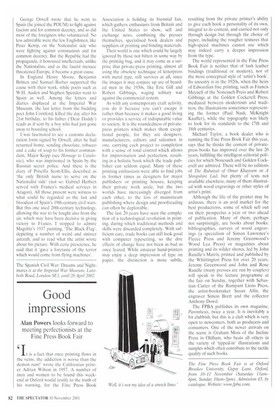Good impressions
Alan Powers looks forward to meeting perfectionists at the Fine Press Book Fair
It is a fact that once printing flows in the veins, the addiction is worse than the demon rum!' wrote the Californian printer Adrian Wilson in 1957. A number of men and women to be found this weekend at Oxford would testify to the truth of his warning, for the Fine Press Book
Association is holding its biennial fair, which gathers enthusiasts from Britain and the United States to show, sell and exchange news, combining the presses themselves, specialised book dealers and suppliers of printing and binding materials.
Their world is one which could be largely ignored by those not bitten in some way by the printing hug, and it may come as a surprise that private-press printing, almost all using the obsolete technique of letterpress with metal type, still survives at all, since the images it may conjure up are of bearded men in the 1930s, like Eric Gill and Robert Gibbings, waging solitary war against the commercial system.
As with any contemporary craft activity, you do it because you can't escape it rather than because it makes a good living or provides a service of indisputable value to society. It is the roundedness of privatepress printers which makes them exceptional people, for they are designers, manufacturers, editors and salesmen in one, carrying each project to completion with a sense of total control which allows for improvisation and perfection, resulting in a holistic book which the trade publisher can seldom equal. Many of these printing enthusiasts were able to find jobs in former times as designers for major publishers or printing houses, keeping their private work aside, but the two worlds have increasingly diverged from each other, to the loss of mainstream publishing where design and proofreading can often be deplorable.
The last 20 years have seen the completion of a technological revolution in printing, during which traditional methods and skills were discarded completely. With sufficient care, trade books can still look good with computer typesetting, so the dire effects of change have not been as bad as once feared. While amateur hand-printers may enjoy a deep impression of type on paper, the distinction is more subtle, resulting from the private printer's ability to give each book a personality of its own, integral to its content, and carried not only through design but through the choice of paper, including the rougher textures that high-speed machines cannot use which may indeed carry a deeper impression from the type.
The world represented in the Fine Press Book Fair is neither that of lush leather bindings (traditional or modern), nor of the more conceptual style of 'artist's book'. Its ancestry is in the 1920s, when the heirs of Edwardian fine printing, such as Francis Meynell of the Nonesuch Press and Robert Gibbings at the Golden Cockerell Press, mediated between modernism and tradition, the illustrations sometimes representing the former (Paul Nash, McKnight Kauffer), while the typography was likely to look for its standards to the 17th and 18th centuries.
Michael Taylor, a book dealer who is running the Fine Press Book Fair this year, says that he thinks the content of privatepress books has improved over the last 20 years, fulfilling the intelligent editorial policies for which Nonesuch and Golden Cockerel] are admired. There will be no editions of The Rubaiyat of Omar Khayyam or A Shropshire Lad, but plenty of texts not available elsewhere, many of them illustrated with wood engravings or other styles of artist's print.
Although the life of the printer may be arduous, there is an avid market for the best productions, some of which sell out on their prospectus a year or two ahead of publication. Many of them, perhaps not surprisingly, are books about books: bibliographies, surveys of wood engravings (a specialism of Simon Lawrence's Fleece Press and Jeremy Greenwood's Wood Lea Press) or magazines about printing and its wilder shores, led by John Randle's Matrix, printed and published by the Whittington Press for over 20 years. Jeremy Greenwood and John and Rose Randle (many presses are run by couples) will speak in the lecture programme at the fair on Sunday, together with Sebastian Carter of the Rampant Lions Press, the artist-bookmaker Susan Allix, the engraver Simon Brett and the collector Anthony Dowd.
The FPBA publishes its own magazine, Parenthesis, twice a year. It is inevitably a bit clubbish, but this is a club which is very open to newcomers, both as producers and consumers. One of the newer arrivals on the scene is Graham Moss of the Incline Press in Oldham, who beats all others in the variety of lipped-in' illustrations and samples which often contribute to the tactile quality of such books.
The Fine Press Book Fair is at Oxford Brookes University, Gypsy Lane, Oxford, from 10-11 November (Saturday I 1 am6pm, Sunday Main—Spm). Admission £5, by catalogue. Website: www.fpba.com.














































































































 Previous page
Previous page